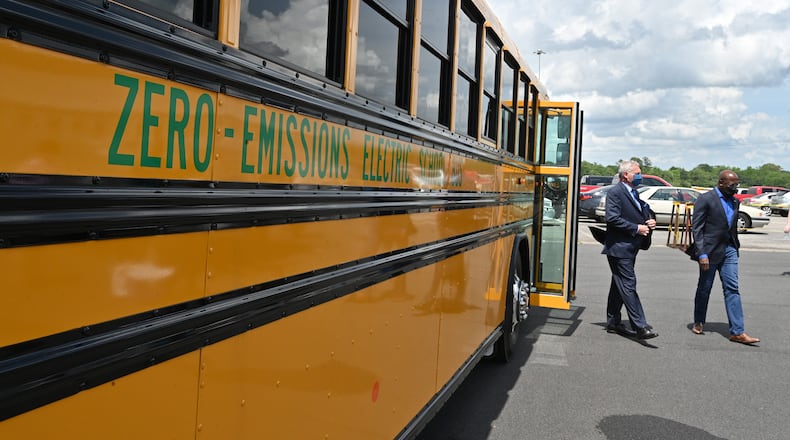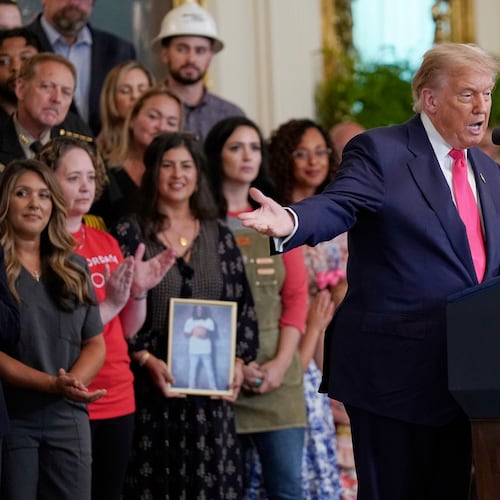FORT VALLEY – Blue Bird engineered its first-generation electric bus in 1994 with an eye toward the Atlanta Olympics.
The model, which utilized lead acid batteries, was designed to ferry athletes and spectators to athletic events. When its sales didn’t take off, the school bus manufacturing giant shelved its electric aspirations for two decades.
Blue Bird got back into the game about five years ago, as the price of batteries decreased and electric vehicles began to disrupt the auto sector.
Now, the century-old company could see a major windfall under the $2.3 trillion infrastructure proposal currently being floated by President Joe Biden, which calls for upward of 20% of the country’s school bus fleet to be replaced with electric vehicles. Separate legislation that’s co-sponsored by Georgia U.S. Sen. Raphael Warnock also could accelerate the technology’s adoption by setting aside $25 billion in grants over 10 years for school boards to switch from diesel-powered to electric buses.
The latter is what brought Warnock to the small city of Fort Valley, about 25 miles south of Macon, on Tuesday.
After being whisked through an industrial stretch of town on a glistening new electric school bus, the first term Democrat said, “This is the green energy jobs future.”
“It’s good for the economy. It’s good for the air for all of us. And it’s certainly great for our children,” Warnock told reporters.
Credit: HYOSUB SHIN / AJC
Credit: HYOSUB SHIN / AJC
The nation’s nearly 500,000 school buses carry about 25 million school children every day, forming what’s effectively the country’s largest public transportation system.
The vast majority of those buses — some 95% — run on diesel, which is widely linked to adverse health effects like asthma, lung cancer and poorer cognitive abilities. Diesel is also a major pollutant. Its exhaust spews carbon monoxide, soot and nitrogen oxides that contribute to smog, acid rain and global warming.
School boards keep diesel buses, however, because they cost about one-third of electric ones. That’s why supporters of electric vehicles, or EVs, say Washington needs to step in and subsidize the technology until costs can be lowered through economies of scale, to put it within reach for many cash-strapped school districts.
“Through this, we can get the cost of production and the cost of our materials down so that, by the end of this period when the funding’s complete, districts won’t need to rely solely on grant funding to add EV to their fleets,” Phil Horlock, Blue Bird’s president and CEO, said of Warnock’s legislation. “It’ll be the new norm.”
Credit: HYOSUB SHIN / AJC
Credit: HYOSUB SHIN / AJC
To date, Blue Bird, which has its headquarters in Macon, has sold about 400 electric buses. That’s relatively large compared to other manufacturers, but EVs still made up only about 1% of the company’s pre-COVID business.
China dominates the global market for electric buses. In June 2019, 99% of the world’s supply was based there. That’s slowly beginning to change as some states and localities, such as California, have created incentives.
Blue Bird said it’s heard from school districts around the U.S. that are interested in switching to EVs. Beyond the health and environmental benefits, some are enticed by the estimated life-cycle costs, which, according to industry statistics, are far lower than diesel buses. Others like the buses’ quiet ride and that they can store energy, which could enable school districts to sell power back to utilities. The problem is, the upfront costs are still prohibitively high for many would-be customers.
“People want them,” said Trevor Rudderham, Blue Bird’s senior vice president for product planning and electrification. “But the issue is they’re very expensive.”
Credit: HYOSUB SHIN / AJC
Credit: HYOSUB SHIN / AJC
Company executives would not share specifics about how much of an uptick in business they’re expecting should the Biden or Warnock proposals pass. But Blue Bird estimated in February that it has a 63% market share on EV buses. If 100,000 buses, or 20% of the current fleet, are replaced in the years to come, that could mean tens of thousands of units in sales.
That would be a notable turnaround for Blue Bird, which struggled financially in 2020 as the pandemic forced many school districts to shift to remote learning, idling buses for months. During its last earning call in February, the company reported that its net sales were down almost 15% from the prior year and gross profits were down 11%. But executives say business has started picking up as in-person learning has resumed.
Under Warnock’s bill, which has the backing of several major environmental groups and the American Federation of Teachers, $10 billion in grants would be set aside for school districts hardest hit by climate change. Administrators could use the funding to cover the labor costs for installing charging stations and the expense of purchasing new buses and providing workforce development and training for bus drivers.
Similar proposals have floated around Capitol Hill for years. An earlier version of Warnock’s proposal was sponsored by Kamala Harris when she served in the Senate, and language was also included in the Green New Deal plan popularized by U.S. Rep. Alexandria Ocasio-Cortez, D-N.Y.
Credit: HYOSUB SHIN / AJC
Credit: HYOSUB SHIN / AJC
Republicans have raised objections to any EV mandate. Many have warned more broadly about relying on China to manufacture batteries for the auto sector — Blue Bird’s come from the Michigan-based XALT Energy — as well as the potential strain to the power grid if thousands of buses are added en masse.
“We need to let the market and consumer choice drive the adoption of EVs,” Congressman Fred Upton, R-Mich., said during a hearing on electric vehicles on Thursday.
Warnock said he sees an opportunity for Georgia to become a hub for EV technology, especially given construction of the SK Innovation battery plant in Commerce.
“This is a worthwhile investment in a sustainable future for our country,” he said.
SCHOOL BUSES IN AMERICA
25 million - Number of k-12 students who take school buses each day
480,000+ - Number of school buses on the road
95% - Percentage of school buses that run on diesel fuel
1% - Percentage of school buses that are electric
Sources: American School Bus Council, U.S. Public Interest Research Group, Interact Analysis
About the Author
Keep Reading
The Latest
Featured









